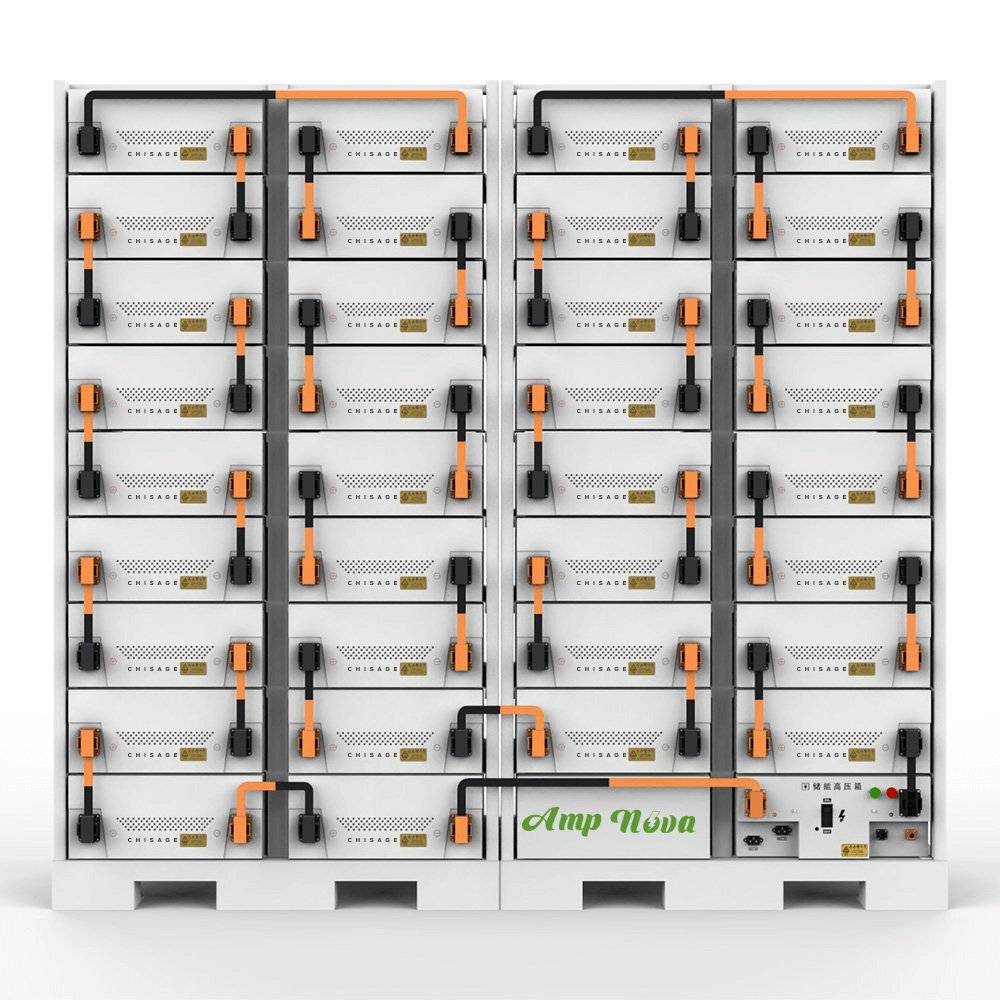- Introduction
- Types of Energy Storage
- Battery Energy Storage Systems
- How Battery Energy Storage Systems Work
- Advantages of Battery Energy Storage Systems
- Applications of Battery Energy Storage Systems
- Flywheel Energy Storage
- How Flywheel Energy Storage Works
- Advantages of Flywheel Energy Storage
- Applications of Flywheel Energy Storage
- Challenges and Future Outlook
- Compressed Air Energy Storage
- How does Compressed Air Energy Storage work?
- Benefits of Compressed Air Energy Storage
- Challenges and Limitations of Compressed Air Energy Storage
- Future prospects
- Thermal Energy Storage
- Principles of Thermal Energy Storage
- Applications of Thermal Energy Storage
- Advantages and Challenges
- Pumped Hydro Storage
- How it works
- Advantages of pumped hydro storage
- Challenges and limitations
- Applications of pumped hydro storage
- Hydrogen Fuel Cells
- How do hydrogen fuel cells work?
- Advantages of hydrogen fuel cells
- 1. Clean and emissions-free
- 2. High energy efficiency
- 3. Versatile applications
- 4. Quick refueling
- Challenges and limitations
- 1. Hydrogen infrastructure
- 2. Cost
- 3. Hydrogen production
- Advances in Energy Storage Technology
- 1. Lithium-Ion Batteries
- 2. Flow Batteries
- 3. Solid-State Batteries
- 4. Thermal Energy Storage
- 5. Compressed Air Energy Storage
- Applications of Energy Storage
- Grid Integration and Stabilization
- Load Shifting and Peak Demand Management
- Renewable Energy Time Shifting
- Backup Power and Uninterrupted Power Supply (UPS)
- Electrification of Transportation
- Microgrids and Remote Power Systems
- Frequency Regulation and Ancillary Services
“What is Energy Storage? Unlocking the Key to a Renewable Energy Future”
Dive into the world of energy storage, an indispensable component in harnessing renewable energy sources.
This comprehensive guide begins by answering the fundamental question: What is energy storage? It then explores its crucial role in managing the balance between energy generation and consumption.
You’ll journey through various storage technologies, from traditional methods like pumped hydro and compressed air to innovative solutions such as lithium-ion batteries and hydrogen fuel cells.
Each technology is dissected for its unique advantages and limitations, essential for maintaining grid stability, enhancing energy efficiency, and reducing reliance on fossil fuels.
This guide goes beyond technicalities, examining factors like cost, scalability, and environmental impact, offering a complete perspective on energy storage as a vital link in our sustainable energy transition.
Embark on this enlightening journey to understand how energy storage is shaping a greener, more reliable energy future.
Contents
Introduction
Energy storage is an essential component of modern power systems, enabling the efficient and reliable management of electricity supply and demand. As the world transitions towards cleaner and more sustainable energy sources, energy storage technologies have become increasingly important.
Energy storage systems store excess electricity generated during periods of low demand and make it available during times of high demand or when intermittent renewable energy sources, such as solar or wind, are not available. By effectively managing supply and demand imbalances, energy storage helps stabilize electric grids, reduces the need for expensive infrastructure upgrades, and enables the integration of intermittent renewable energy sources into the grid.
This comprehensive guide aims to provide a clear understanding of energy storage concepts, technologies, and applications. It will cover various types of energy storage systems, their operating principles, advantages, limitations, and potential applications in different sectors.
Key topics covered in this guide include:
- Battery Energy Storage Systems (BESS): Battery energy storage is one of the most widely used and versatile storage technologies. This section will delve into the different types of batteries, their characteristics, applications, and considerations for integrating BESS into power grids.
- Pumped Hydro Storage: Pumped hydro storage is a mature and reliable technology that uses gravitational potential energy to store and generate electricity. This section will explore the working principles, advantages, and limitations of pumped hydro storage systems.
- Thermal Energy Storage (TES): Thermal energy storage is a method of storing heat or cold for later use. This section will cover various TES technologies, including sensible heat storage, latent heat storage, and thermochemical storage, and their applications in heating, cooling, and industrial processes.
- Flywheel Energy Storage: Flywheel energy storage systems harness the energy of a rotating mass to store and release electricity. This section will explain the working principles of flywheel energy storage, its advantages, and limitations.
- Compressed Air Energy Storage (CAES): CAES systems store energy by compressing air into underground caverns and releasing it to generate electricity when needed. This section will examine the different types of CAES systems, their characteristics, and potential applications.
- Hydrogen Energy Storage: Hydrogen has emerged as a potential energy carrier and storage medium that can facilitate the integration of renewable energy into various sectors. This section will explore hydrogen production, storage, and utilization techniques, as well as their benefits and challenges.
- Integration, Control, and Grid Applications: This section will discuss the challenges and solutions related to the integration, control, and grid applications of energy storage systems. It will cover topics such as grid-scale deployment, smart grid integration, advanced control strategies, and regulatory considerations.
Understanding energy storage systems and their potential applications is crucial for policymakers, grid operators, renewable energy project developers, and individuals interested in the transition toward a more sustainable and resilient energy future. With this guide, readers will gain a comprehensive overview of energy storage technologies available today and their role in shaping the future of the power sector.
Types of Energy Storage
Energy storage technologies can be categorized into different types based on the method used to store energy. Each type of energy storage has its own advantages, disadvantages, and suitability for different applications. Here are some common types of energy storage:
- Batteries: Batteries are one of the most widely used energy storage technologies. They work by converting chemical energy into electrical energy and can be recharged multiple times. Different types of batteries exist, including lithium-ion, lead-acid, and nickel-cadmium, each with its own characteristics and applications. Batteries are commonly used in portable electronics, electric vehicles, and grid-scale energy storage systems.
- Pumped Hydro Storage: Pumped hydro storage is a well-established and widely used method for storing energy. It involves using excess electrical energy to pump water from a lower reservoir to a higher reservoir. When electricity demand is high, the water is released, flowing downhill through turbines to generate electricity. Pumped hydro storage systems can store large amounts of energy and have a long lifespan but require specific geographic conditions.
- Compressed Air Energy Storage (CAES): CAES involves compressing air and storing it in underground caverns or tanks. When electricity demand increases, the compressed air is released and expanded through a turbine to generate electricity. This technology is suitable for large-scale energy storage applications and can help balance fluctuations in electricity supply and demand.
- Thermal Energy Storage (TES): Thermal energy storage systems store energy in the form of heat or cold. They work by storing energy during periods of low demand and releasing it when needed. TES can use different mediums such as molten salts, phase change materials, or chilled water. It has various applications, including heating and cooling buildings, industrial processes, and solar thermal power plants.
- Flywheel Energy Storage: Flywheel energy storage systems store energy in a rotating mass. When excess energy is available, the flywheel spins at a high speed, storing energy in its rotational momentum. When needed, the stored energy is converted back to electricity. Flywheels can respond quickly to fluctuations in demand and are often used for short-duration energy storage in applications like uninterruptible power supplies (UPS) and frequency regulation.
- Hydrogen Storage: Hydrogen storage involves storing hydrogen gas for later use as an energy source. Hydrogen can be produced using various methods, such as electrolysis or steam methane reforming. It can be stored in tanks or used in fuel cells to generate electricity. Hydrogen storage has the potential to provide long-duration energy storage and play a role in decarbonizing multiple sectors, including transportation and power generation.
- Supercapacitors: Supercapacitors, also known as ultracapacitors, store energy electrostatically. Unlike batteries, they store and release energy quickly, making them suitable for applications requiring high power bursts. Supercapacitors have a longer lifespan and can withstand a higher number of charge-discharge cycles than batteries, but they have lower energy density.
- Chemical Storage: Chemical energy storage involves converting electrical energy into chemical energy for later use. This includes methods such as hydrogen production through electrolysis, fuel production through electrochemical processes, or other chemical reactions that store energy. Chemical energy storage can provide long-duration storage and has the potential to play a crucial role in renewable energy integration.
Each type of energy storage technology has its own set of advantages, limitations, and applications. The choice of energy storage solution depends on factors such as required energy capacity, duration of storage, cost-effectiveness, environmental impact, and the specific needs of the application or system. By understanding the different types of energy storage, stakeholders can make informed decisions regarding the implementation of suitable solutions for their energy storage requirements.
Battery Energy Storage Systems
Battery energy storage systems (BESS) are becoming increasingly popular as a means to store and utilize electrical energy. These systems are comprised of rechargeable batteries that can store electricity during periods of low demand and discharge it when demand exceeds supply. BESS is capable of providing high-power output and responds quickly to load fluctuations, making them ideal for applications such as peak shaving, load balancing, and grid reliability enhancement.
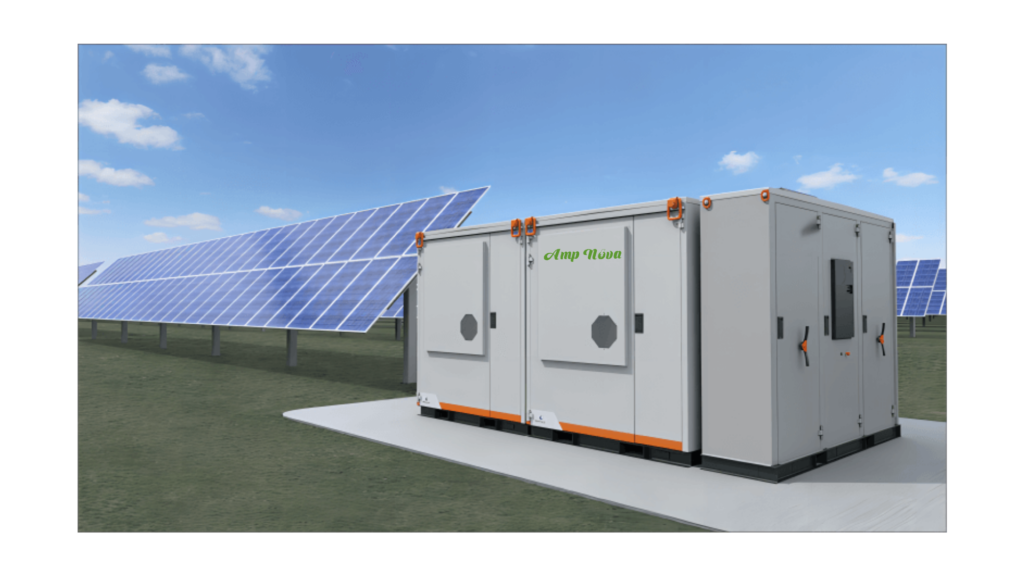
How Battery Energy Storage Systems Work
BESS stores electrical energy by converting it into chemical energy through a process called charging. During charging, electrical energy is supplied to the battery, causing chemical reactions to occur within the battery cells. These reactions result in the storage of electrical energy in the form of electrochemical potential energy.
When electricity is needed, the stored energy is converted back into electrical energy through a process called discharging. The battery releases stored energy by reversing the chemical reactions that occurred during charging. This conversion from chemical to electrical energy enables the battery to power devices or feed electricity back into the grid.
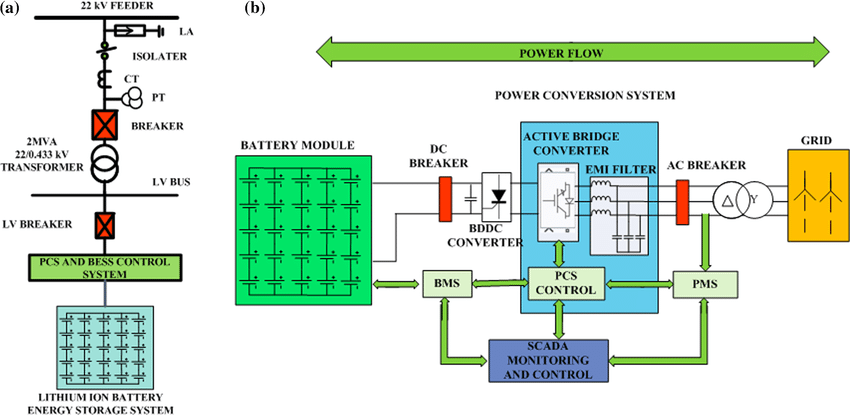
Advantages of Battery Energy Storage Systems
Battery energy storage systems offer several advantages that make them an attractive solution for various energy storage needs:
- Flexibility: BESS can be scaled up or down to meet specific energy requirements, making them adaptable for both small-scale and large-scale applications.
- Fast Response: BESS can respond rapidly to changes in demand or supply, providing instantaneous power when needed. This characteristic makes them suitable for frequency regulation and load balancing in grid systems.
- Modularity: BESS are composed of individual battery cells that can be easily connected in series or parallel to achieve the desired capacity. This modularity makes it simple to expand or replace components as needed.
- Environmentally Friendly: As battery technologies improve, the use of renewable energy sources to charge the batteries becomes more prevalent. This promotes a cleaner and more sustainable energy grid.
- Cost Savings: Battery energy storage systems can help reduce overall energy costs by storing electricity during off-peak hours when rates are lower and using it during peak hours when rates are higher. Additionally, they can avoid costly infrastructure upgrades by providing localized backup power in areas with high energy demand.
Applications of Battery Energy Storage Systems
BESS have a wide range of applications across different sectors. Some common applications include:
- Renewable Integration: BESS can store excess energy generated from intermittent renewable sources, such as solar and wind, and supply it during periods of low generation or high demand.
- Microgrids: BESS can be utilized to create standalone power systems or augment existing electrical grids in remote areas. They provide stable and reliable power, reducing reliance on traditional fossil fuel-based generators.
- Commercial and Industrial Applications: BESS can help large commercial and industrial facilities manage peak demand and avoid utility demand charges by providing stored energy during periods of high electricity consumption.
- Residential Energy Storage: BESS can empower homeowners to store excess solar energy generated during the day and use it at night, helping to reduce reliance on the grid and lower energy costs.
In conclusion, battery energy storage systems offer a wide range of benefits and applications in the field of energy storage. With their flexibility, fast response, modularity, environmental friendliness, and cost-saving potential, BESS are poised to play a significant role in the transition to a more sustainable and resilient energy grid.
Flywheel Energy Storage
Flywheel energy storage is a promising technology for the efficient storage and retrieval of mechanical energy. It involves storing energy in the form of rotational motion by spinning a massive wheel, known as a flywheel, at high speeds. The stored energy can then be converted back into electricity when needed.
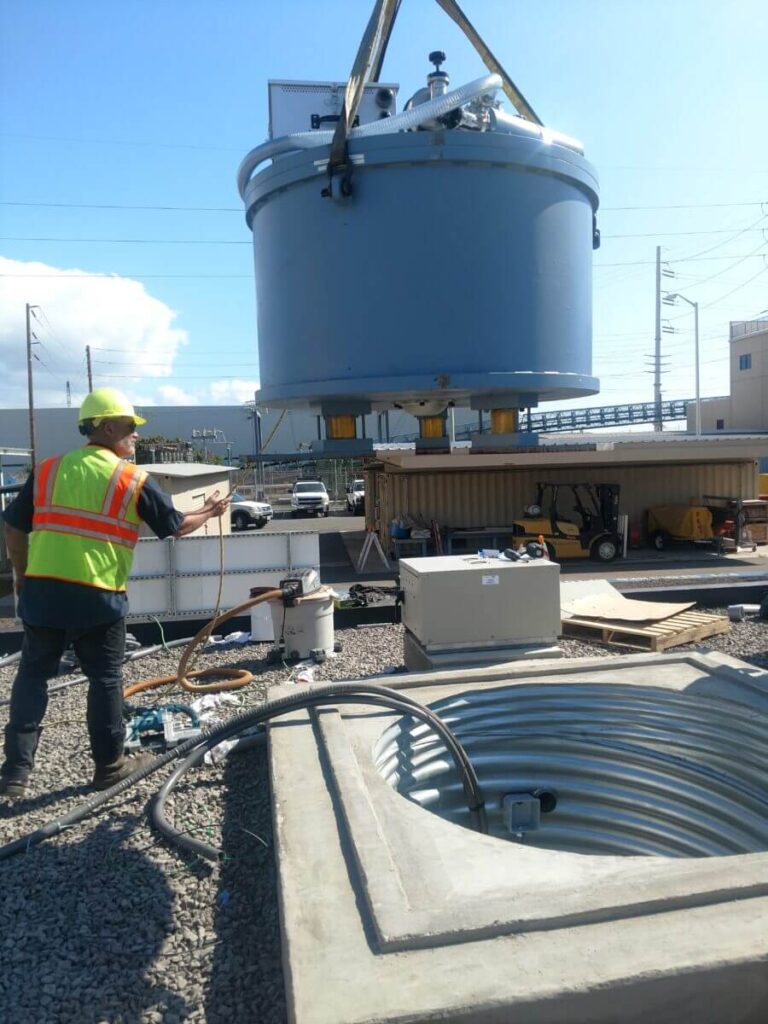
How Flywheel Energy Storage Works
The basic principle behind flywheel energy storage is that kinetic energy can be stored in the rotational motion of a mass. The greater the mass and the higher the rotational speed, the more energy can be stored. Typically, flywheels are made of materials with high tensile strength, such as carbon fiber composites, to withstand the high stresses generated at high speeds.
The energy storage process involves accelerating the flywheel using an electric motor to convert electricity into rotational motion. As the flywheel spins, it stores energy due to its increased rotational speed. The energy can be extracted when needed by reversing the process. The rotational motion of the flywheel is converted back into electricity using a generator, which can then be fed back into the electrical grid or used to power devices.
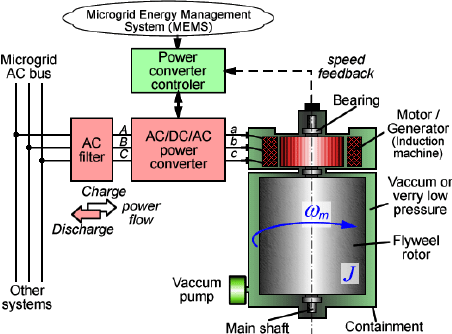
Advantages of Flywheel Energy Storage
Flywheel energy storage offers several advantages compared to other energy storage technologies:
- High Power Output: Flywheels can provide high power output within a short period. They can respond quickly to changes in demand, making them suitable for applications that require rapid bursts of energy, such as grid stabilization, frequency regulation, or backup power supply.
- Long Operational Lifespan: Since flywheels do not rely on chemical reactions, they have a longer operational lifespan compared to batteries. They can withstand a high number of charge/discharge cycles without significant degradation, resulting in extended system life and reduced maintenance costs.
- Efficiency: Flywheel energy storage systems have high efficiency levels, typically above 90%. This means that the amount of energy input is almost equal to the amount of energy output, resulting in minimal losses during the storage and retrieval processes.
- Environmental Friendly: Flywheels do not use hazardous chemicals or produce harmful emissions during operation. They have a minimal environmental impact, making them a cleaner choice for energy storage.
Applications of Flywheel Energy Storage
Flywheel energy storage has various applications across different sectors, including:
- Grid Stabilization: Flywheels can provide rapid response and frequency regulation services to stabilize electrical grids. They can help balance the supply and demand of electricity, ensuring a stable and reliable power supply.
- Renewable Energy Integration: Flywheels can play a crucial role in integrating intermittent renewable energy sources, such as wind and solar, into the grid. They can store excess energy generated during peak production periods and release it during periods of low production or high demand.
- Uninterruptible Power Supply (UPS): Flywheels can be used as backup power systems for critical infrastructure, such as data centers or hospitals, where uninterrupted power supply is essential.
- Electric Vehicles: Flywheel systems can be used in electric vehicles to store energy and provide quick acceleration or enhanced regenerative braking capabilities.
Challenges and Future Outlook
While flywheel energy storage offers numerous advantages, there are still some challenges to overcome. One significant challenge is the energy loss due to friction and air resistance, which can limit the overall efficiency of the system. Ongoing research is focused on reducing these losses and improving the flywheel’s energy storage capacity.
Looking ahead, advances in materials science, manufacturing techniques, and system design are expected to enhance the performance and cost-effectiveness of flywheel energy storage. As renewable energy integration and grid stability become increasingly important, flywheels have the potential to play a pivotal role in the transition towards a cleaner and more efficient energy future.
Compressed Air Energy Storage
Compressed Air Energy Storage (CAES) is a unique energy storage technology that harnesses the power of compressed air to store and release energy. It offers a promising solution for managing the fluctuations in electricity supply and demand by storing excess energy during low-demand periods and releasing it during high-demand periods.
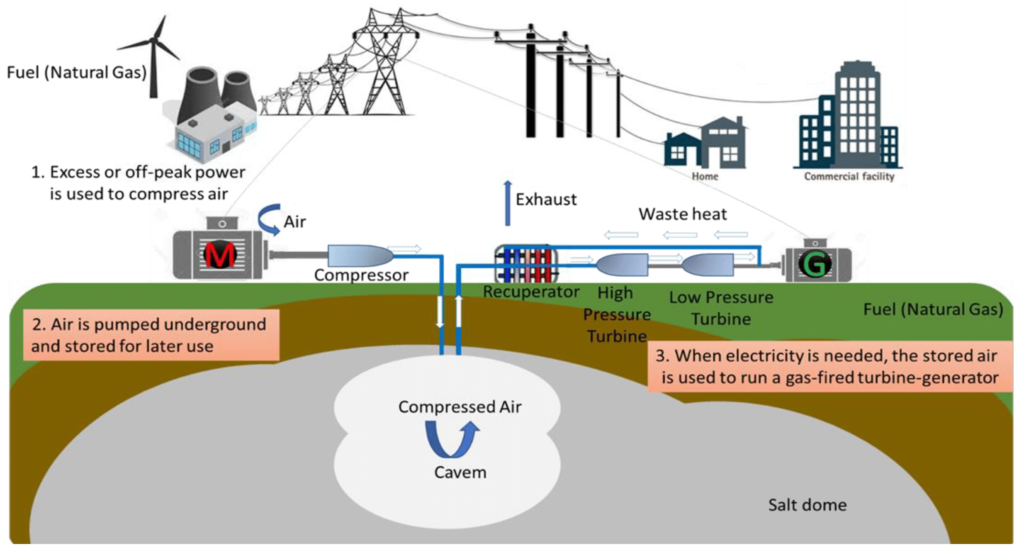
How does Compressed Air Energy Storage work?
Unlike many other energy storage methods, CAES involves a two-step process. The first step is the compression of air, using excess electricity from the grid when power demand is low. The compressed air is stored in underground caverns or above-ground storage tanks. During this compression process, heat is generated, which is usually discarded.
The second step involves the expansion of the compressed air. When there is a demand for electricity, the compressed air is released and passes through a turbine. As the air expands, it drives the turbine, which generates electricity. The released air can be mixed with natural gas or other fuels to enhance power generation and improve overall efficiency.
Benefits of Compressed Air Energy Storage
- Large-scale energy storage: CAES has the potential for large-scale energy storage, making it suitable for utility-scale applications. The storage capacity can range from several hundred megawatt-hours (MWh) to multiple gigawatt-hours (GWh), depending on the size of the storage facility.
- Flexibility and grid stability: By storing excess electricity during times of low demand and releasing it during times of high demand, CAES helps stabilize the electrical grid. It can also provide supplementary electricity during peak demand periods, reducing strain on the grid.
- Reliability and longevity: CAES systems have a long operational life, typically ranging from 30 to 50 years. The technology has a proven track record of reliability and can provide a stable source of energy storage for decades.
- Integration with renewable energy sources: CAES can effectively integrate with renewable energy sources such as wind and solar power. It can absorb excess energy generated by these intermittent sources and release it when needed, facilitating a more efficient and reliable renewable energy grid.
- Environmental considerations: CAES has the potential to reduce greenhouse gas emissions by displacing fossil fuel-based electricity generation during periods of peak demand. Additionally, the technology can make use of abandoned underground mines or other suitable caverns for air storage, minimizing its environmental impact.
Challenges and Limitations of Compressed Air Energy Storage
- Geographical restrictions: The availability of suitable geological formations for underground caverns required for CAES can be limited, restricting the location of storage facilities.
- Energy efficiency: The compression and expansion processes in CAES can result in energy losses. Researchers are continuously exploring ways to improve efficiency and minimize energy losses during the storage and release cycles.
- Environmental impact: Although CAES is considered a clean energy storage technology, there are potential environmental concerns associated with the materials used in the compression and storage processes. The impact on local ecosystems and air quality needs to be carefully assessed and mitigated.
Future prospects
Compressed Air Energy Storage holds great potential for large-scale energy storage and integration with renewable energy sources. Ongoing research and development efforts aim to improve the efficiency, cost-effectiveness, and environmental performance of this technology. With advancements in technology and the increasing demand for energy storage solutions, CAES is expected to play a significant role in the future energy landscape.
Thermal Energy Storage
Thermal energy storage (TES) is a method of storing heat or cold generated from thermal energy sources for later use. It plays a crucial role in balancing energy supply and demand, particularly in the context of renewable energy. TES allows excess thermal energy to be stored during periods of low demand and released during times of high demand or when the primary heat source is unavailable.
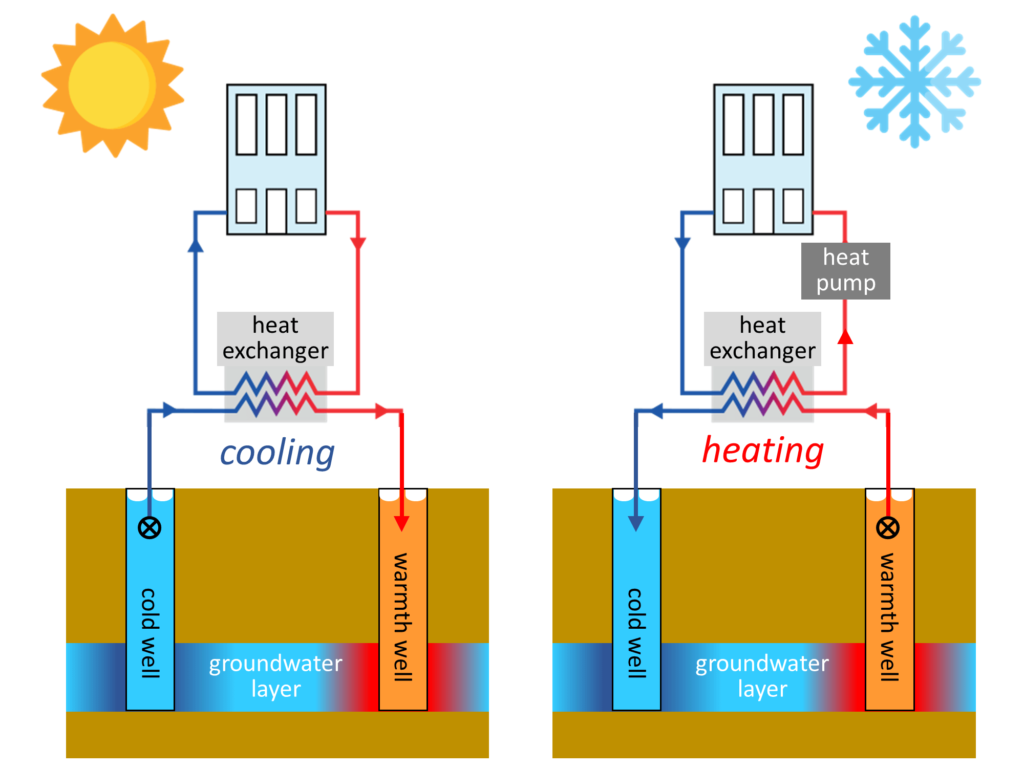
Principles of Thermal Energy Storage
There are various principles and techniques used in thermal energy storage. These methods involve the storage of heat or cold within a medium, which can later be accessed and utilized. Some common principles of TES include:
- Sensible Heat Storage: In this method, thermal energy is stored by raising or lowering the temperature of a material, typically in the form of a solid or liquid. The heat is added or extracted directly from the storage medium, such as rocks, concrete, or water. Sensible heat storage is suitable for applications where temperature differentials are not extreme.
- Latent Heat Storage: Latent heat storage involves the use of a phase change material (PCM) to store thermal energy. The PCM absorbs or releases heat during the process of changing from one phase to another, such as from solid to liquid or liquid to gas. This type of storage allows for a large amount of energy to be stored or released within a narrow temperature range, making it ideal for certain heating or cooling applications.
- Thermochemical Heat Storage: Thermochemical reactions can also be employed for thermal energy storage. This method involves the storage of energy through reversible chemical reactions. During charging, heat is applied to drive an endothermic reaction, which stores the energy. When the stored energy is required, the reaction is reversed by supplying heat.
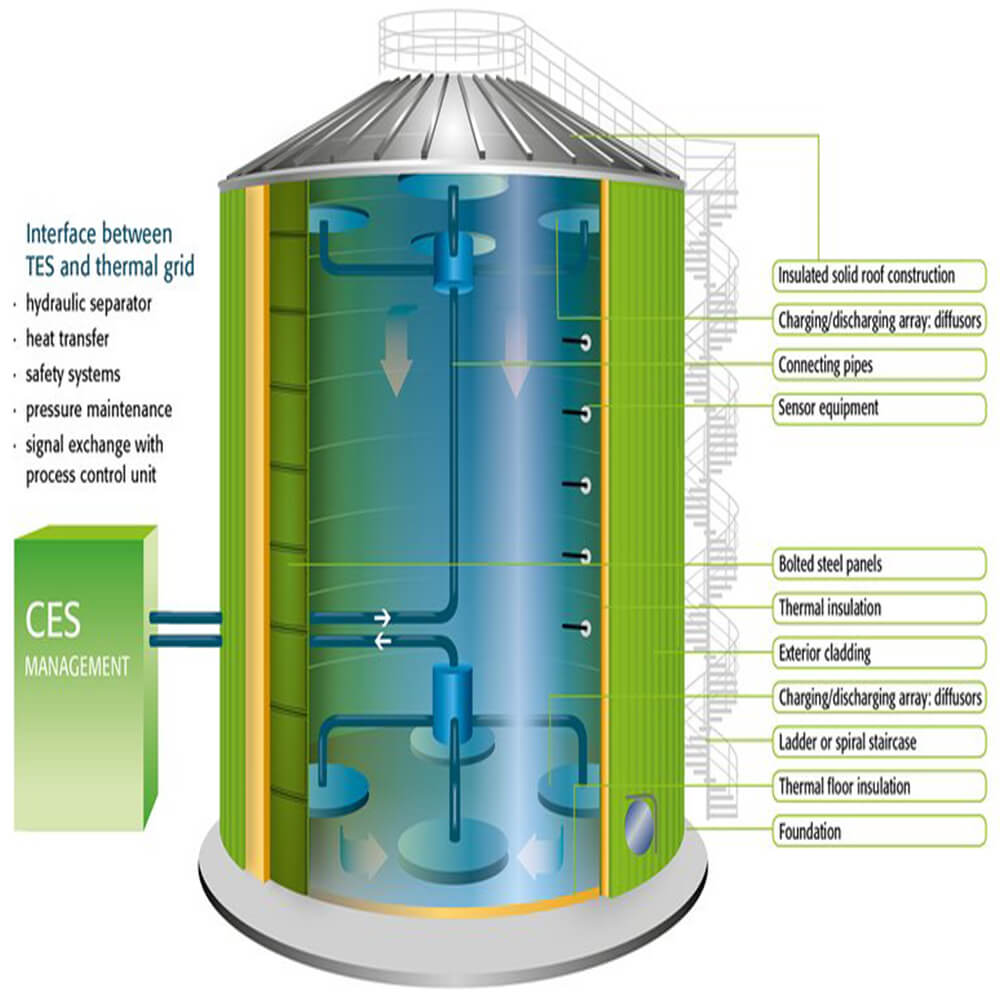
Applications of Thermal Energy Storage
Thermal energy storage systems find numerous applications across various sectors. Here are some notable applications:
- District Heating and Cooling: Thermal energy storage can be used in district heating and cooling systems to store excess heat or cold generated from central energy plants. This allows for a flexible supply of heating or cooling to meet fluctuating demand.
- Solar Energy Storage: TES systems can be used in conjunction with solar energy systems to store excess thermal energy generated during the day for use during the night or cloudy periods. It enhances the efficiency and reliability of solar power plants by ensuring a continuous supply of energy.
- Industrial Processes: Many industrial processes require high-temperature heat or cooling. TES systems can provide a reliable and cost-effective way to store and utilize thermal energy for such applications, reducing operational costs and improving process efficiency.
Advantages and Challenges
Thermal energy storage offers several advantages:
- Efficient utilization of excess thermal energy by storing it for later use when demand is higher.
- Increased flexibility and stability for energy systems by balancing supply and demand.
- Reduction of peak loads and optimization of energy distribution.
- Integration of renewable energy sources into the grid by buffering intermittent supply.
However, challenges persist with certain aspects of thermal energy storage:
- High initial investment costs associated with the installation of TES systems.
- Selection of suitable storage technologies and materials to ensure optimal performance and longevity.
- Limited availability of proven and cost-effective storage solutions for some specific applications.
To overcome these challenges, ongoing research and development efforts are focused on improving the efficiency, durability, and cost-effectiveness of thermal energy storage technologies.
In conclusion, thermal energy storage is a critical component of the energy landscape, allowing for the efficient storage and utilization of excess heat or cold. As renewable energy sources continue to gain importance, the role of TES in balancing supply and demand will become even more significant, contributing to a more sustainable and resilient energy future.
Pumped Hydro Storage
One of the oldest and most commonly used methods of energy storage is pumped hydro storage. This technology is a form of hydroelectric power generation that stores energy by pumping water from a lower-elevation reservoir to a higher elevation reservoir during times when electricity is abundant and inexpensive. Then, during periods of high demand or when electricity prices are higher, the stored water is released through turbines to generate electricity.
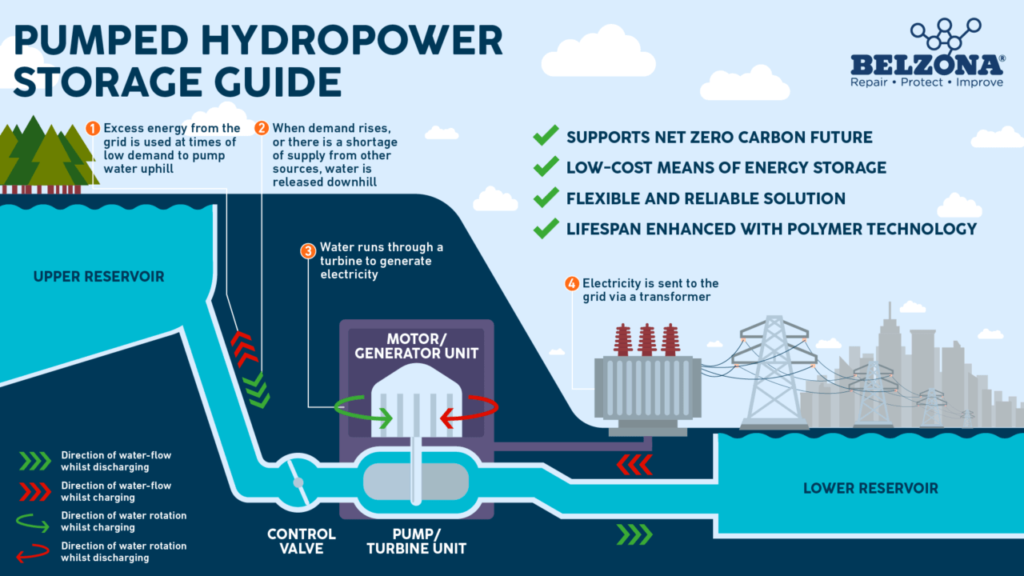
How it works
Pumped hydro storage systems consist of two reservoirs at different elevations, connected by pipes and tunnels. During periods of low electricity demand, excess electricity from the grid is used to pump water from the lower reservoir to the upper reservoir, effectively storing the energy as potential energy. The pumping process requires energy input from an external source, such as a power plant or renewable energy sources like wind or solar farms.
When electricity demand increases, or during peak periods, the water stored in the upper reservoir is released back to the lower reservoir. Gravity pulls the water downhill, passing through turbines that generate electricity. The generated electricity is then fed back into the grid, meeting the increased demand.
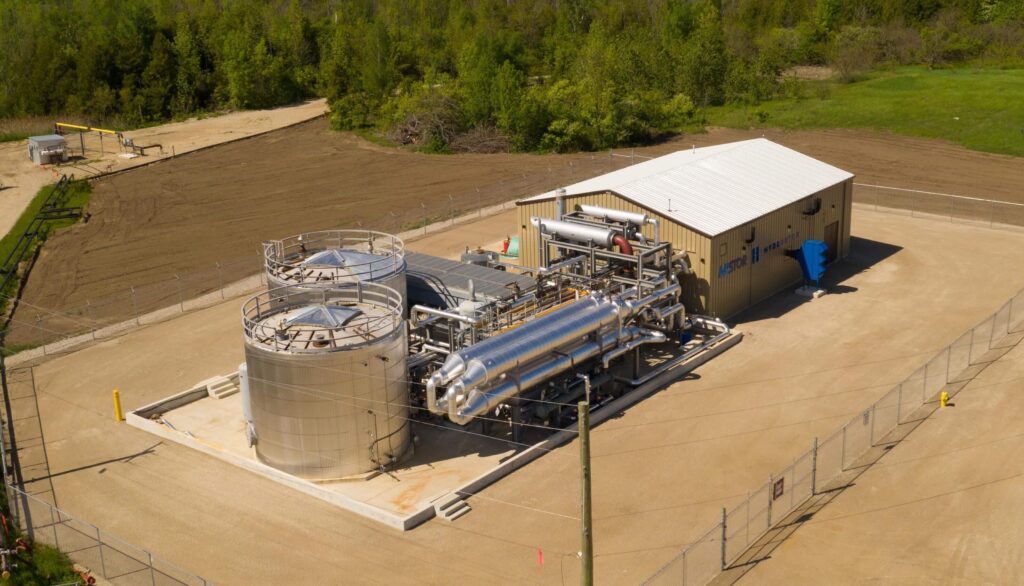
Advantages of pumped hydro storage
Pumped hydro storage offers several advantages over other forms of energy storage:
- Large-scale storage capacity: Pumped hydro storage facilities can store large amounts of energy for extended periods, ranging from hours to even several days. This makes them suitable for balancing variable energy supply and demand, providing grid stability, and ensuring a reliable energy supply.
- Long lifespan: Pumped hydro storage systems typically have a lifespan exceeding 50 years, making them a durable and reliable solution for long-term energy storage needs.
- High efficiency: This technology boasts high round-trip energy efficiency, typically reaching 70-80%. This means that for every unit of electricity used to pump water uphill, the system can generate 0.7 to 0.8 units of electricity when releasing the stored water downhill.
- Environmental friendliness: Pumped hydro storage is considered a clean energy storage technology since it relies on the use of water as the energy carrier. It does not produce greenhouse gas emissions during operations, thereby contributing to a more sustainable energy system.
Challenges and limitations
Despite its many advantages, pumped hydro storage does face some challenges and limitations:
- Geographical constraints: The availability of suitable sites for constructing pumped hydro storage facilities can be limited by the availability of two reservoirs at different elevations with sufficient capacity. Additionally, the construction of such facilities may have environmental and social impacts, including potential disruption to ecosystems and displacement of communities.
- High capital costs: Building pumped hydro storage facilities requires significant capital investment due to the construction of the reservoirs, pipes, and tunnels. This can limit the widespread deployment of the technology in regions with limited financial resources.
- Water availability: Adequate water resources are crucial for the operation of pumped hydro storage systems. Water scarcity or restrictions on water usage can limit the feasibility of implementing such projects in certain regions.
Applications of pumped hydro storage
Pumped hydro storage is widely used across the world and plays a vital role in ensuring the stability and reliability of electrical grids. Some key applications of pumped hydro storage include:
- Grid stability: Pumped hydro storage can help balance the fluctuating supply and demand of electricity, providing a stable and continuous energy supply to the grid.
- Renewable energy integration: This technology enables the integration of intermittent renewable energy sources, such as wind and solar, by storing excess energy during periods of high production and releasing it when demand is high.
- Peak shaving: Pumped hydro storage facilities can provide additional power during peak demand periods, reducing the need for expensive and polluting peaker plants.
- Emergency backup: Pumped hydro storage can serve as an emergency backup power source during outages or grid disruptions, ensuring energy availability in critical situations.
In conclusion, pumped hydro storage is a mature and reliable method of energy storage, offering large-scale storage capacity, high efficiency, and long lifespan. While facing some challenges and limitations, this technology continues to play a crucial role in maintaining grid stability, integrating renewable energy sources, and providing backup power.
Hydrogen Fuel Cells
Hydrogen fuel cells are an exciting technology that holds great potential for energy storage and sustainable power generation. A hydrogen fuel cell is an electrochemical device that converts hydrogen gas and oxygen into electrical energy, heat, and water. It offers a clean and efficient alternative to traditional combustion engines, making it an attractive option for a greener future.
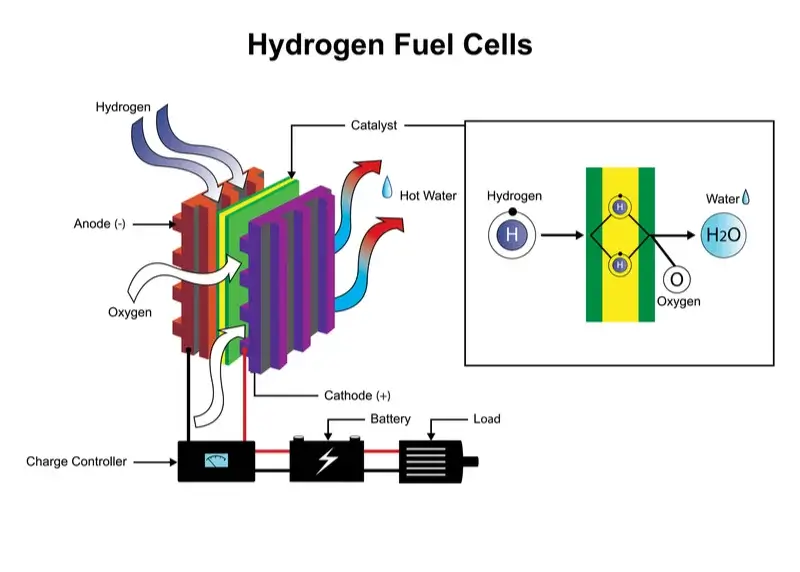
How do hydrogen fuel cells work?
Hydrogen fuel cells work through a process that involves the chemical reactions between hydrogen and oxygen. The cell consists of three main components: an anode, a cathode, and an electrolyte. Hydrogen gas is fed into the anode, while oxygen (usually from the air) is supplied to the cathode. The electrolyte, often a proton-conducting polymer membrane, separates the anode and cathode.
At the anode, hydrogen gas is split into protons (positively charged particles) and electrons. The protons pass through the electrolyte, while the electrons travel through an external circuit, creating an electrical current. At the cathode, the protons, electrons, and oxygen react to produce water as a byproduct. This combination of chemical reactions results in the generation of electricity, which can be harnessed for various applications.
Advantages of hydrogen fuel cells
1. Clean and emissions-free
Hydrogen fuel cells are renowned for their low environmental impact. The only byproduct of the electrochemical reaction within the fuel cell is water, making them a catalyst for reduced greenhouse gas emissions. They don’t emit pollutants or produce harmful emissions, contributing to improved air quality and reducing our dependence on fossil fuels.
2. High energy efficiency
Fuel cells offer remarkable energy efficiency compared to traditional energy conversion methods. They can convert chemical energy directly into electrical energy with an efficiency of up to 60%. This high efficiency helps maximize the utilization of the stored energy and reduces waste, making them an excellent option for sustainable power generation.
3. Versatile applications
Hydrogen fuel cells have a wide range of potential applications across various industries. They can be used to power electric vehicles, providing a cleaner and more sustainable alternative to internal combustion engines. Additionally, they can be used for stationary power generation, offering a reliable source of electricity for homes, buildings, and remote areas. The adaptability of fuel cells makes them suitable for diverse scenarios, contributing to a more sustainable energy landscape.
4. Quick refueling
Unlike conventional batteries, hydrogen fuel cells can be refueled relatively quickly, similar to filling up a gas tank. This feature eliminates the need for long charging times, which is especially crucial for applications in transportation, allowing for efficient and seamless operation.
Challenges and limitations
While hydrogen fuel cells offer numerous advantages, there are also challenges and limitations to consider.
1. Hydrogen infrastructure
One of the main obstacles to the widespread adoption of hydrogen fuel cells is the lack of infrastructure. Establishing a network of hydrogen production, storage, and distribution facilities requires significant investment and coordination. Without a comprehensive infrastructure, scaling up the use of hydrogen fuel cells becomes challenging.
2. Cost
Currently, the production and implementation costs of hydrogen fuel cells are relatively high. This factor limits their accessibility and mass adoption. However, ongoing research, technological advancements, and economies of scale are expected to drive down costs over time.
3. Hydrogen production
The majority of hydrogen is currently produced from fossil fuels, primarily through a process called steam methane reforming. This method contributes to carbon emissions and contradicts the goal of a clean and sustainable energy system. To fully realize the environmental benefits of hydrogen fuel cells, it is crucial to develop and implement renewable methods of hydrogen production.
In conclusion, hydrogen fuel cells have the potential to play a significant role in the future of energy storage and sustainable power generation. Their ability to provide clean and efficient energy, versatility, and quick refueling make them a promising technology. While challenges exist, ongoing efforts to develop infrastructure, reduce costs, and promote renewable hydrogen production will be instrumental in realizing the full potential of hydrogen fuel cells.
Advances in Energy Storage Technology
In recent years, there have been significant advancements in energy storage technology, revolutionizing the way we store and utilize energy. These developments have helped to unlock the full potential of renewable energy sources, overcome the limitations of traditional power grids, and enhance the reliability and resilience of our energy systems. Here are some key advances in energy storage technology:
1. Lithium-Ion Batteries
Lithium-ion batteries have emerged as a game-changer in energy storage. These high-density battery systems have become the preferred choice for portable electronics, electric vehicles, and grid-scale energy storage. They offer a high energy density, long cycle life, and fast charging capabilities. The continued research and development in lithium-ion battery technology have led to improvements in performance, safety, and cost-effectiveness, making them an attractive option for various applications.
2. Flow Batteries
Flow batteries are a promising technology that utilizes two electrolyte solutions separated by a membrane to store energy. They offer the advantage of decoupling energy capacity and power, allowing for flexible scaling of storage capacity. Flow batteries have a longer lifespan and can withstand thousands of charge and discharge cycles without significant degradation. These characteristics make them suitable for large-scale energy storage, particularly for renewable energy integration and grid stabilization.
3. Solid-State Batteries
Solid-state batteries are a next-generation energy storage technology that replaces the liquid electrolyte found in traditional batteries with a solid-state electrolyte. This design eliminates the risk of leakage, improves safety, and enables the use of higher energy storage materials. Solid-state batteries also promise higher energy densities, faster charging rates, and longer lifespans than their lithium-ion counterparts. Although still in the development stage, solid-state batteries hold great potential for various applications, including electric vehicles and grid storage.
4. Thermal Energy Storage
Thermal energy storage (TES) systems store thermal energy in various mediums, such as water or molten salt, for later use. TES systems utilize the difference in temperature to store and retrieve energy, providing a flexible and efficient solution. They play a crucial role in enhancing the integration of renewable energy sources, as they can store excess energy produced during off-peak times and release it during peak demand periods. TES systems are commonly used in concentrated solar power plants, district heating, and cooling systems, and industrial processes.
5. Compressed Air Energy Storage
Compressed air energy storage (CAES) is a technology that stores energy in the form of compressed air. During periods of low demand, excess electricity is used to compress air and store it in underground reservoirs, such as geological formations or salt caverns. When electricity demand increases, the compressed air is released and expanded through a turbine to generate electricity. CAES provides a large-scale, grid-integrated storage solution, offering a high energy storage capacity and the ability to respond rapidly to fluctuations in demand.
These advances in energy storage technology have the potential to transform our energy landscape by enabling greater utilization of renewable energy sources, improving grid stability, and addressing the challenges associated with intermittent generation. Continued research and development in energy storage will further enhance efficiency, cost-effectiveness, and sustainability, paving the way for a cleaner and more resilient energy future.
Applications of Energy Storage
Energy storage systems have a wide range of applications across various sectors. These systems play a crucial role in improving the performance, efficiency, and reliability of energy systems. Here are some key applications of energy storage:
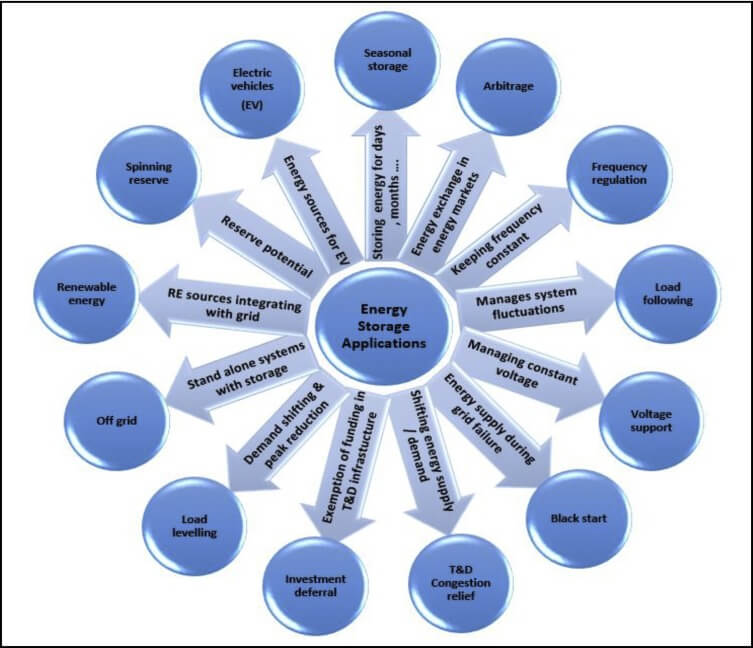
- Grid Integration and Stabilization
Energy storage technologies can be effectively utilized to integrate renewable energy sources into the grid. As solar and wind power generation fluctuates with weather conditions, energy storage systems can store excess energy during periods of high generation and supply it to the grid during low generation periods. This helps to balance supply and demand, stabilize the grid, and enhance grid reliability.
- Load Shifting and Peak Demand Management
Energy storage systems enable load shifting by storing excess energy during periods of low demand and releasing it during peak demand periods. This helps to reduce strain on the grid during peak hours and avoid the need for additional power plants or transmission infrastructure. Commercial and industrial facilities can also utilize energy storage systems to manage their energy consumption and reduce peak demand charges.
- Renewable Energy Time Shifting
Energy storage systems allow for time shifting of renewable energy generation. For example, excess solar power generated during daylight hours can be stored and used during the night, when solar generation is unavailable. This maximizes the utilization of renewable energy and ensures a continuous and reliable power supply from intermittent sources.
- Backup Power and Uninterrupted Power Supply (UPS)
Energy storage systems serve as backup power sources during grid outages or blackouts. Residential, commercial, and industrial users can rely on energy storage systems to provide uninterrupted power supply, critical for essential operations, emergency services, and sensitive equipment. UPS systems are particularly vital for data centers, hospitals, and other facilities where power interruptions can have severe consequences.
- Electrification of Transportation
Energy storage plays a vital role in enabling the electrification of transportation. Battery storage systems in electric vehicles store energy to power the vehicles, allowing for zero-emission transportation. Additionally, energy storage infrastructure such as charging stations and battery swapping stations facilitate the widespread adoption of electric vehicles by providing convenient and efficient charging solutions.
- Microgrids and Remote Power Systems
Energy storage is crucial in microgrid and remote power systems, where access to a reliable grid may be limited or non-existent. Energy storage systems, in combination with renewable energy sources, provide a stable and sustainable power supply for isolated communities, military bases, islands, and remote industrial sites. These systems enhance energy independence and resilience in areas with unreliable grid connections.
- Frequency Regulation and Ancillary Services
Energy storage systems can provide fast response times and precise control over power output, making them valuable for frequency regulation and other ancillary services. These services help maintain grid stability, balance supply and demand, and ensure the delivery of high-quality electricity.
Energy storage is transforming the energy landscape by enabling a more flexible, sustainable, and reliable energy system. As technology continues to advance and costs decrease, the applications of energy storage are expected to expand even further, presenting new opportunities for a cleaner and more efficient energy future.
Are you seeking insights into Commercial and Industrial (C&I) Energy Storage and electrical systems? We recognize the complexities involved in constructing or enhancing such systems, and we’re ready to offer our support. Contact our sales and customer service team at [email protected].
